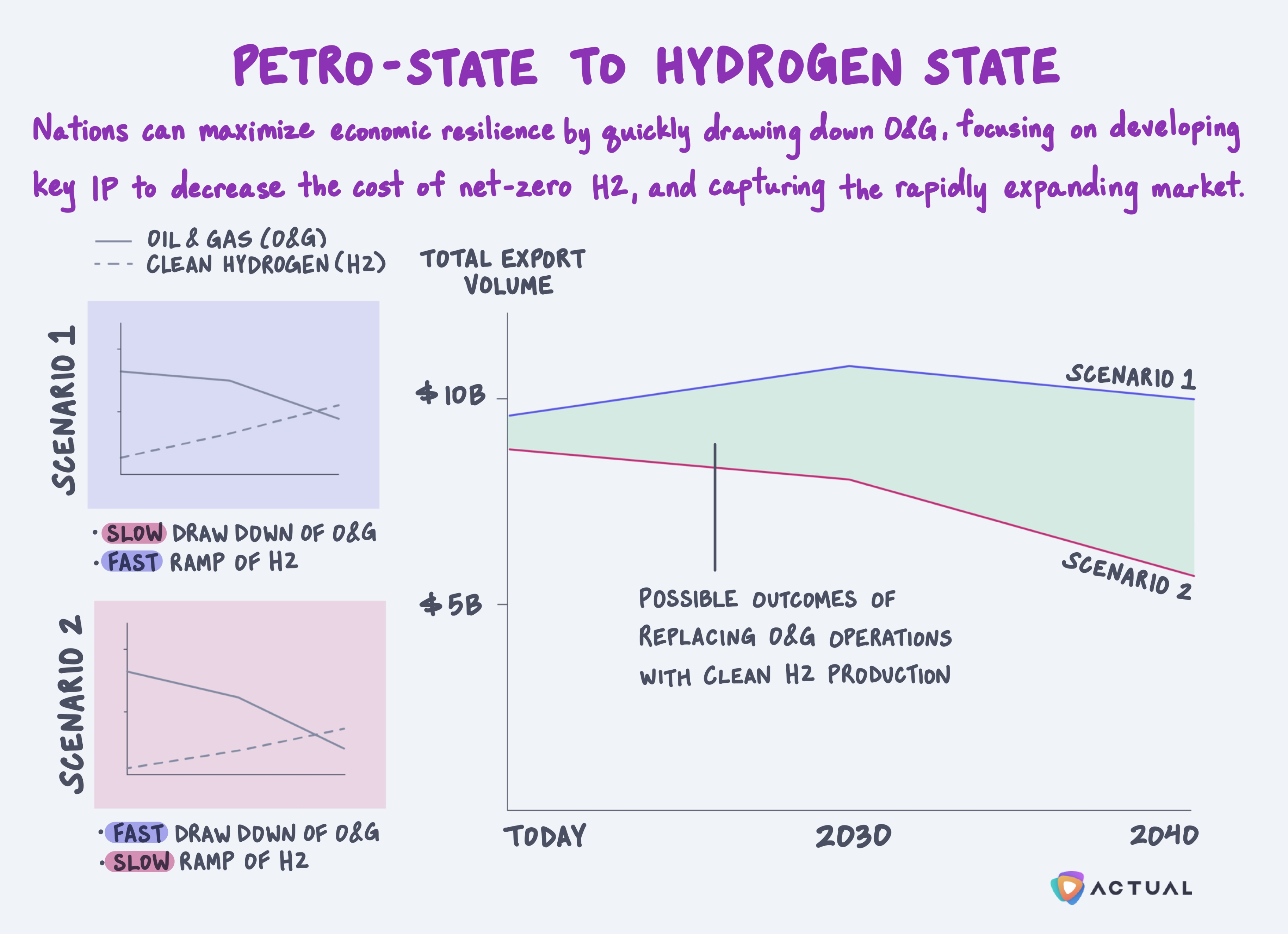
February 23, 2024
Petro-State to Hydrogen State
Climate change is changing the trajectory of the oil and gas economy. During COP28, the Oil and Gas Decarbonization Charter was introduced, with over 50 government and privately owned companies—representing nearly 40% of global oil production—committing to achieving net-zero operations by 2050.
Countries are either importers or exporters of oil and gas, such as Denmark and Norway, respectively. As demand from major importers decreases during the energy transition, oil and gas exporting nations will undergo a dramatic economic shift.
Heavy oil and gas exporters must consider hydrogen production to remain competitive and relevant during the energy transition, recognizing clean hydrogen as an emerging commodity with higher market potential.
How does this affect you?
Policymakers need to drive investment throughout the hydrogen value chain to ensure the economic viability and competitiveness of net-zero hydrogen.
Oil and gas CFOs and planning teams need to prepare for the evolving fuel industry by positioning themselves to take advantage of an emerging market.
R&D teams need to seize the opportunity to innovate and secure IP rights for emerging technologies, particularly those facilitating cost-effective hydrogen production, thus enabling them to capture market opportunities effectively.
Investors need to identify industry shifts and opportunities in both supply and demand for hydrogen technology.

Norway generates 98% of its electricity from renewable sources and exports significant amounts to neighboring countries. The nation has rapidly advanced the energy transition by being among the first to implement carbon taxes and participate in the EU Emissions Trading System (ETS), which establishes a price for industrial emissions.
However, as a significant oil economy, Norway pumps over four million barrels of oil equivalent per day, exporting emissions ten times greater than its domestic production. Despite imposing one of the highest carbon taxes, Norway not only restricts imports but also generates revenue through taxes levied on its oil supply chain.
So how do major oil exporters stay relevant in a post-oil economy? While there's no simple solution, investing immediately in blue hydrogen production and transitioning to green hydrogen over time can be a navigable course for the transition. However, to successfully transition to a hydrogen economy, we must dispel certain myths:
Blue hydrogen is not inherently clean. The colors of hydrogen (gray, blue, green) do not indicate carbon intensity but rather the technical production process. Blue hydrogen is often contested due to the additional emissions associated with carbon capture systems (CCS). Although less efficient than green hydrogen production, blue hydrogen can be made ‘clean’ using renewables to power steam methane reforming (SMR) and CCS.
Blue hydrogen is defined at the political level. Countries like the US have set very clear guidelines for what is eligible for blue hydrogen, dictating the technical requirements for its production.
To fulfill energy needs, clean hydrogen is necessary to address the 15% of emissions from hard-to-decarbonize sectors such as aviation and heavy industry. Today's challenge lies in the disparity between supply and demand, but the hydrogen market is emerging, and its growth can be greatly accelerated with appropriate policies and financial investments.
Historical data show that learning rates and technological advancements directly correlate with investments. For instance, past solar projections indicated an average annual cost reduction of around 2.6%. However, costs decreased by 15% per year; a similar trend is also seen with wind power. While solar costs plateaued during economic downturns, prices steeply declined again as interest in solar energy surged around 2012.
As the hydrogen economy picks up, investments in clean hydrogen will inevitably foster innovation, driving greater supply and demand and dramatic cost reductions. This makes it clear that green investments and planning cannot be formulated using historical trends and projections.
Countries that look to transition from oil and gas to hydrogen must prioritize the rapid advancement of hydrogen technology, as it is the key driver of value. This positions them to secure IP rights, which drives cost reductions, allowing them to capture the hydrogen market and offer affordable hydrogen solutions.
Why should major oil economies like Norway invest in hydrogen production?
Changing landscape. Clean hydrogen will reshape current industry networks and create openings for new markets. Denmark is a prime example of a major oil and gas importer that effectively shifted away from reliance on these resources. In contrast, Australia, previously not heavily engaged in oil and gas, has entered a new market by exporting clean hydrogen as a commodity.
Ready infrastructure. Norway boasts of a robust renewable energy network that can facilitate the production of clean hydrogen without significant additional investments.
Government technology investments. Funding for the state climate investment company, Nysnø Climate Investments, is allocated by oil and gas revenue. However, investments can be focused on clean hydrogen technology without changing the fund’s structure.
Earlier this year, Norway awarded 62 offshore oil and gas exploration licenses despite its recent commitments to the Oil Decarbonization Charter at COP28. While integrating hydrogen production with new and existing operations presents an optimal solution, we must remain pragmatic. Blue hydrogen presents an opportunity for asset utilization until the end of life but does not justify more in the future: it’s a transitional strategy rather than a final one. However, one thing is certain—investing in hydrogen technology is a calculated risk worth taking.
Until next time,
Actual
More recent newsletters
April 25, 2024
ACTUAL
Catalonia, Spain, has recently declared a drought emergency as reservoirs plunge to critically low levels at just 15% of full...
April 11, 2024
ACTUAL
The automotive industry has been undergoing a drastic transformation, transitioning from combustion engine vehicles to include EVs, hybrid engines, and...
March 21, 2024
ACTUAL
The thrilling races of Formula 1 are powered by behind-the-scenes innovation, where even the slightest tweaks in aerodynamics or engine...


